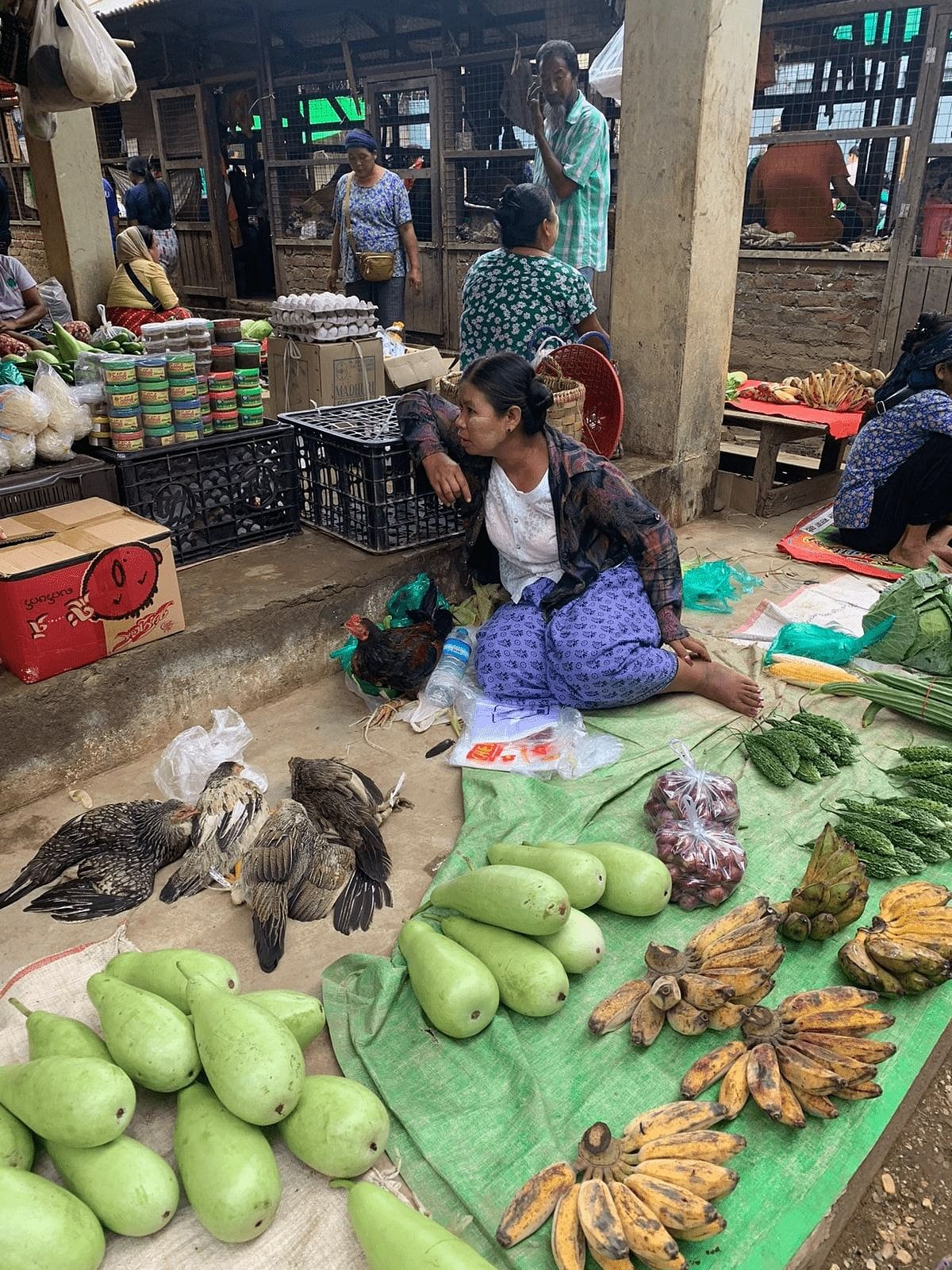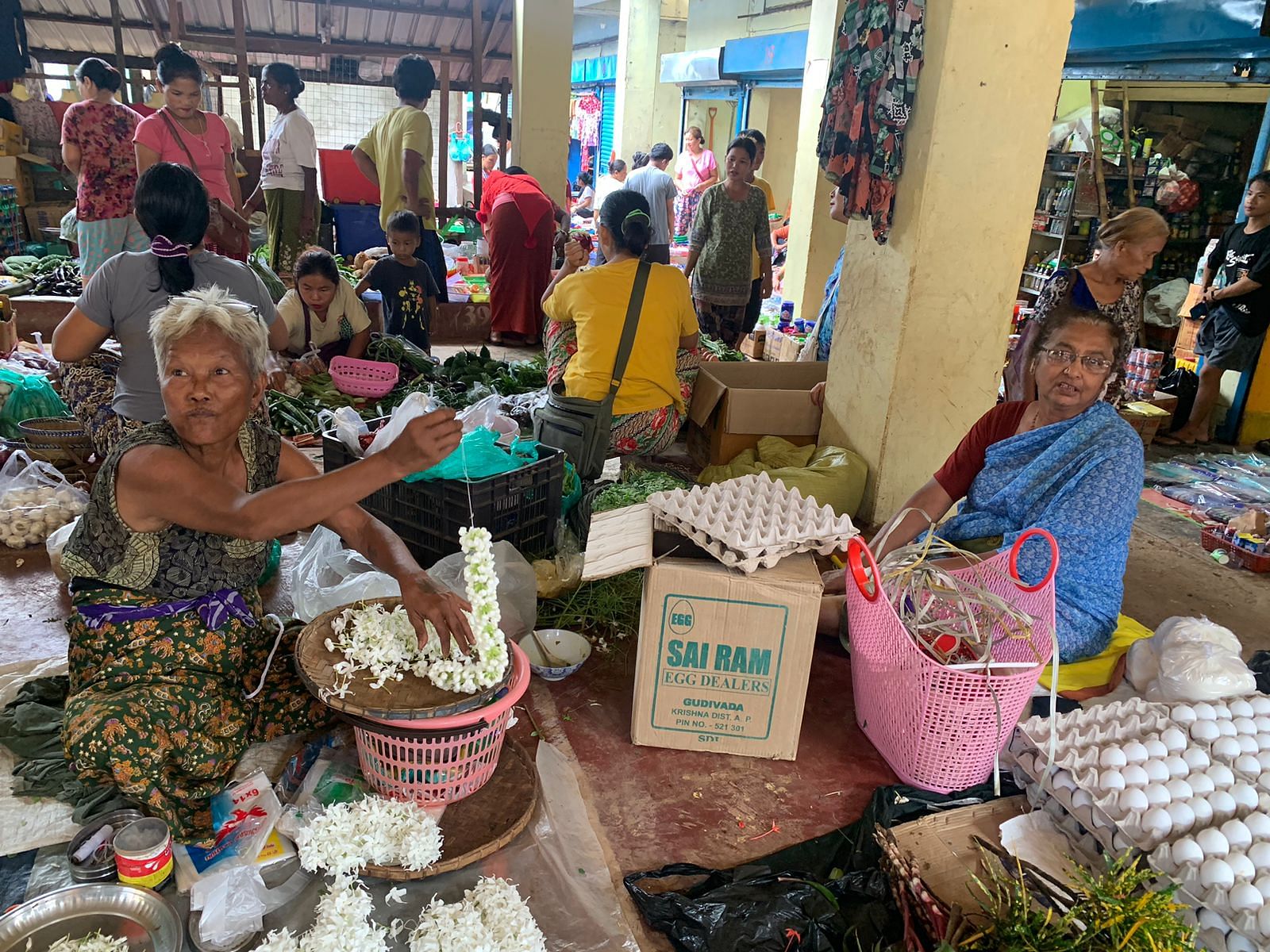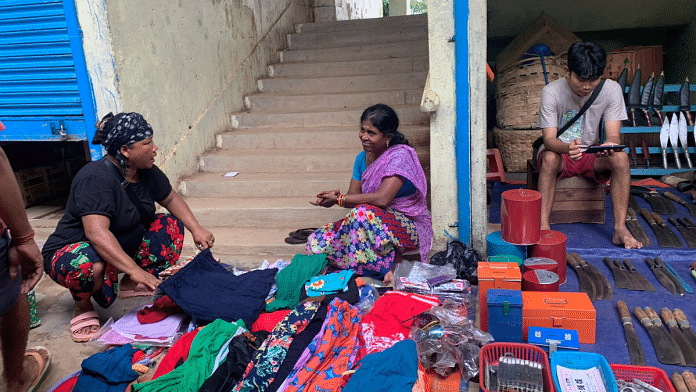Moreh: Aunty A takes a clandestine route from her strife-torn town of Tamu in Myanmar through the jungles of Haolenphai to reach Moreh market in Manipur. It’s barely three kilometres away, but by the time she arrives with her basket of steamed delicacies at the crack of dawn, the border town market in Manipur’s Tengnoupal district is a symphony of cacophony. Hundreds of vendors, both from India and Myanmar, have already laid out their wares—bucket hats and garlands of fresh flowers, cosmetics and clothes, Myanmar’s famous Tun Shwe Wah pain-relief balm, and sambar powder from Tamil Nadu.
But there are no buyers.
Barring a few local residents, the usually bustling market is bereft of shoppers. And it has been like this for the past four months.
Trade troubles
The recent ethnic conflict between the Kukis and the Meitei community in Manipur has severely impacted this informal but once-vibrant cross-border trade. The business had already been keeling under the violent clashes between junta troops and local resistance forces after the 2021 coup in Myanmar. With raids and bombings in Tamu, and check posts under constant surveillance, trade between Moreh and Tamu took a hit. Now, it’s worse.
The Tamils first started trade in Moreh, but the Punjabis and Marwaris expanded it by dealing in all kinds of products, including motor parts, cosmetics, and confectionery – KBS Maniam, general secretary of Tamil Sangam
Vendors from Myanmar are questioning whether it’s worth dodging bullets and bombs to travel to Moreh.
Aunty A quickly unpacks her basket of goodies and arranges them neatly on an aisle. There’s mone pao, the popular sticky rice cakes with lentils, and mi pao, stuffed rolls with bamboo shoots and tiny shrimps, and banana sweets that she sells for Rs 20-30 each. Next to her, 22-year-old Manni, who is also from across the border, is selling khow suey for Rs 30 a bowl. They have barely a few hours to do business — from 6 am to 2 pm — before curfew is imposed by the Tengnoupal district administration.

“Firing goes on at our side. We have to quickly wrap up business lest violence breaks out in Moreh. The border people suffer the most. Business is not at all good,” says 57-year-old Aunty A, her words a rapid staccato, much like the bursts of gunfire in her hometown Tamu.
Everyone is alert and tense and has already chalked the day as another loss. The visible trail of destruction, the detritus of the ethnic clash in the form of broken walls, shuttered doors, debris of bricks and cement, burnt remains of buildings, empty streets, and abandoned stores in Moreh town are a reminder of the volatility of the situation. As many as 3,700 residents in this Kuki-dominated town have been displaced since 3 May when the violence flared up. In July 2023, a mob burnt abandoned houses and shops, said a vendor.
Only 10 km of the 390 km porous border between India and Myanmar in Manipur is fenced.
In another section of the market, 70-year-old Anjamma, who lives in Moreh, arranges her pickled berries, ground spices, and sambar masala. “Before the violence, I would earn Rs 1,000 a day. Now, it’s barely Rs 100,” she says.

Earlier, buyers would come from as far as Imphal; Meiteis and Kukis would trade with each other. Now, traders and customers are left waiting for a solution, their patience running thin. By afternoon, the market falls silent, and the lack of business reverberates not just in this border town but across Manipur.
“If the Kukis and Meiteis don’t negotiate, there can be no hope for border trade to resume, says Leishanthem Brojendra, general secretary of Meitei Council Moreh. He has been living at a relief camp in Moreh since 18 August and is among the 205 Meitei residents repatriated by the Indian government from Myanmar.
Also read: Why Assam Rifles’ vilification is a calculated, conniving move for revenge
High inflation, low hopes
In Moreh, most of the business involves the local residents, and they want milk, flour, rice, and vegetables. With supply lines in Manipur badly hit by the ongoing ethnic strife, it’s the vendors from Myanmar who smuggle these basic necessities across the border.
The heart of this trading hub is the one-storeyed ‘supermarket’ in Ward no. 3. It’s a massive community hall where everything, including rice cookers, grinders, and fans are sold. The streets around the ‘supermarket’ have organically developed into thriving hubs of trade, attracting small vendors and wholesalers. The Moreh bazaar, which was used primarily by the Meiteis, was burned down during the violence.
“Most of the high-class traders and shopkeepers are not able to do business because the border is completely sealed. Small vendors sit for a few hours and go home,” says KBS Maniam, general secretary of Tamil Sangam, a civil society organisation in Moreh.
“A gas cylinder at Moreh costs Rs 3,000, while in Imphal, it sells for Rs 1,000-Rs 1,300,” says Surinder Singh Patheja, general secretary of Moreh’s Border Trade Chamber of Commerce. He blames the “multiple blockades and counter-measures” by the Meitei and Kuki groups.
“Locals are suffering — the price of rice and vegetables has escalated. There is no ration. In four months, the government has provided rice only once. Others are managing through different means, even getting it from Myanmar,” he adds.

Khaiginmang Guite, president of the civil society group Kuki Inpi Tengnoupal, lists the rising price of dal to emphasise the same point and demands that roadblocks be lifted to allow for free movement of goods and produce.
“Construction materials like cement cannot be brought in, as goods carriers are not let into Moreh from Imphal,” he complains.
But even if trucks laden with cement roll into town, they would remain unused. There are no workers left—many fled Moreh during the violence.
Moreover, the border town doesn’t have a homegrown industry that its residents can fall back on. The majority of local residents are daily wage workers who earn a living by carting goods from the border and occasionally, government projects.
“Because of the curfew here and the political situation in Myanmar, we cannot send out any goods. Neither can we get any goods from Imphal,” says Esther Thethem, general secretary of the Kuki Women Union.
A few traders from Myanmar even rent warehouses and shops to store their stock of goods so that they don’t have to lug them back to Tamu every day. A Gurkha Myanmar trader says that her friend’s rented godown was gutted when ethnic violence spread through Moreh.
“Moreh contributes an estimated 40-50 per cent of the state’s economy,” Patheja insists. There is no official data to support this. “The government’s inability to solve the current crisis has gone against the business [interests] in Manipur.”
Also read: Internet shutdown didn’t protect Manipur. Govt used it to hide its shame
Everyday life in the region
Trade between Tamu and Moreh teetered even before the ethnic conflict in Manipur flared up—first during the Covid-19 pandemic and later when Myanmar’s military seized power on 1 February 2021. By March that year, international gates I and II at Moreh were shut down to halt the tide of refugees streaming into India.
Vendors like Aunty A claim they have to pay extortion money to militia groups in Myanmar to cross the border.
Tamu and the rest of Sagaing Region have been torn apart by civil strife due to the emergence of armed militia groups. On the one side is the ultra-nationalist group Pyu Saw Htee, a network of pro-military and armed villagers aligned to the junta’s cause. On the other is the National Unity Government (NUG)’s armed wing called the People’s Defence Forces (PDF).
Traders from Myanmar claim that both Pyu Saw Htee and the PDF have established multiple tax collection points at every town along the trade route. The NUG, however, insists it’s the Pyu Saw Htees who are the extortionists.
“Pyu Saw Htees are collecting taxes illegally. And authorities on the Indian side are restricting the movement of people because of the security situation in Moreh. Border trade is officially stopped, but illegal trade has been going on,” an NUG official told ThePrint over the phone.

Fighter jets, bombings, and gunfire are now part of everyday life in the region.
“There are about 5,000 Nepalis in Tamu. The Pyu Saw Htee raid houses at night. They check vehicles daily. All trade routes are closed and we don’t have enough to eat,” says Rajni (name changed) from the Gurkha community in Myanmar. She moved to Kale in Sagaing Region and then to Tamu about 40 years ago.
In June, the junta conducted aerial bombings at Pantha village, seven miles from Tamu, an NUG official says. Earlier this month, fighter jets carried out an air strike on Bokkan village, 24 miles south of Tamu.
“No one was killed, but some PDF members sustained injuries. Around 300 people had been displaced at Pantha, but have returned home now,” says the NUG representative at Tamu.
Traders who have the means are already shifting to other hubs along Myanmar’s borders with China and Thailand. The Muse-Ruili checkpoint at the China-Myanmar border, among the busiest in South Asia, reopened in January, after over 1000 days of closure due to the Covid-19 pandemic.
“Business is now shifting to Thailand and China borders. And people from Tamu are migrating to cities like Mandalay, Yangon, Monywa, and border areas,” the NUG official told ThePrint.
Many traders in Moreh have shifted base to other border areas such as Mizoram and Arunachal Pradesh in India’s Northeast.
Also read: Delays, security challenges — how turmoil in Myanmar is holding back India’s ‘Act East Policy’
Moreh through the decades
Once an obscure post on Manipur’s map, Moreh started coming into its own in the early 1960s. With the establishment of military rule in Myanmar, Burmese Indians, mainly Tamils and Sikhs who had established trade and commerce in Rangoon and other cities over generations, returned to India and started settling in Moreh, according to Maniam and Patheja.
They successfully established links with traders from Myanmar, leading to rapid growth of ‘illegal’ trade between the two countries.
“It’s the Tamil community that started business between Myanmar and India in Moreh,” says Maniam. “The Tamil women began trading with the Burmese, which was illegal. Our women used to carry essential commodities like sugar, salt, soap, and even lungis, but not in bulk.”
The women would take their wares to the paddy fields in the border regions and barter with their counterparts from Myanmar for grains and pulses, which they sold in Moreh.
Around the same time, the migrant Punjabi community from Myanmar that arrived in Manipur in 1964 began trading in iron products, motor components, and spare parts. Patheja claims that it was the Punjabi and Marwari Jain families that expanded business in Moreh.
“We could not compete with the market in big cities of India, wherever we settled. It was difficult to survive. Some people suggested we travel to Moreh because we came from Myanmar and knew the language,” he says.
Patheja’s forefathers saw the wisdom in making Moreh their home. On reaching, they did what they knew best—trade.
“People with little capital managed to swap things. The Tamils first started trade in Moreh, but the Punjabis and Marwaris expanded it by dealing in all kinds of products, including motor parts, cosmetics, and confectionery,” he adds.
There are currently about 3,000 Tamils scattered across Moreh, and five families have “permanently left” the town since the ethnic conflict began, said KBS Maniam. The small community of Sikhs comprises about 12 houses and 20 people. These families do not wish to leave Moreh.
Also read: Chaos in Myanmar moving closer to Indian border, aerial bombings around 4 km from Manipur
‘Where shall we go?’
Every day, Rajni and her sister Lakshmi (name changed) travel to Moreh from Tamu with packs of readymade clothes and pay Rs 100 for the to-and-fro journey. Reaching an undisclosed location near the border, they hire Indian auto drivers to reach the Moreh market. These days, they barely sell two garments a day.
On paper, the Free Movement Regime (FMR) between India and Myanmar allows tribals living along the border areas to travel 16 km into each other’s country without a visa. It was implemented in 2018 to boost local trade and business, but it became a thorny issue after the 2021 coup.
The international border between Northeast India and Myanmar remains a viable option for smugglers, traffickers, and insurgents. The Assam Rifles, Manipur Police, and its Narcotics and Affairs of Border have been routinely seizing huge quantities of drugs, weapons and illegal goods. Both sides of the border have also been fighting a common war — against insurgency.
But ethnic and cultural ties between the two regions run deep, and borders delineated by the British remain porous despite the Indian government sealing all entry points to stem the tide of refugees. On 25 August, the Tengnoupal administration started capturing the biometrics of “identified illegal immigrants” from Myanmar, a government official said.
“Many Myanmar nationals and Nepalis from Sagaing Region have entered Moreh for safety and are living as refugees,” says Patheja. But it cuts both ways. Rajni and her sister had also met a few Moreh residents in Tamu who had fled the violence. “The Nepalis donated clothes to them,” she says.
By noon, a sense of restiveness ripples through the Moreh market. Curfew is just two hours away, and it’s time to cross the border. Aunty A, Rajni, and the other vendors start packing their unsold items, baked goods, powders, balms, and cosmetics.
Business is now shifting to Thailand and China borders. And people from Tamu are migrating to cities like Mandalay, Yangon, Monywa, and border areas – NUG official
Jhagalal Dkl and his wife, also from Tamu, pack the undergarments they hawk at Moreh. They are uncertain if they will return the next day.
“In Myanmar, there is only gunfight — no income, no food, no safety. In India, too, the authorities don’t sympathise with us. They don’t let us reach the market. At times, they won’t even allow us to sit near the border. Where shall we go?” he asks.
(Edited by Humra Laeeq)



